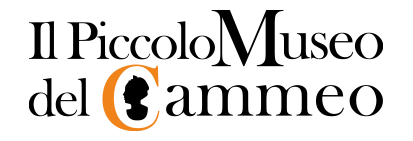Design & Processing
The conformation of the shells, particularly the Cypraecassis rufa and the cassis Madagascariensis, is very particular as they present raised "bumps" and hollows which influence the final result of the subject which is preferably engraved in low relief.
For this reason, the design of the subject must be adapted to the shape of the cameo and not to any specific market needs.
The head-head
Almost all Cypraecassis rufa cameos are made from that part of the "cup" whose colouring is more contrasted and which in the shell coincides with the area proximal to the siphonal canal; by virtue of this necessity, since the colouring of the bottom of the shell is not homogeneous, which on the left side of the piece is very light, the Torre del Greco artists are forced to engrave the faces with the profile turned to the right and with the hair in the most coloured part of the cup, which is also the most valuable, it is called "head-head".
The problem does not exist for cameos made on Cassis Madagascariensis.
Processing
Even today, cameo making is still done by hand. The first phase of the process consists in choosing the right shell for engraving.
Next we move on to the " Scappatura ", that is, the cutting of the most convex part of the shell, the cup; then we proceed to the " Signatura " and the " Shaping " of the cut piece:
Inside the cup, the outlines of the cameos to be obtained are traced and the superfluous parts are eliminated by cutting them, obtaining polygonal shaped pieces.
We move on to the " Aggarbatura ", which consists of giving the piece the desired shape (usually oval or round) using a special grinding wheel.
The piece obtained then passes to the " Mess in pece ", it is fixed on a wooden spindle with hot mastic composed of Greek pitch, wax and scagliola.
After this operation we move on to the "scraping" or "flattening" that is the abrasion of the outermost part of the shell in order to leave the clear layer to be engraved. The work passes to the engraver who draws the subject to be reproduced on the surface.
Cameo workmanship reached its peak during the Renaissance. Today these examples, some of which were made and embellished with precious materials, are present in the Medici collections or preserved in the most important museums around the world.
But what shells are used to make cameos? And why does the background color vary from salmon to pink to brown?
The shells most suitable for this type of processing all come from distant seas and obviously have different characteristics, both in shape and size and in colour.
The most widely used ones belong to the cassis species which includes three types that are particularly suited to highlighting the engraving, thanks to their more intensely coloured background.
The shell par excellence?
The Cassis madagascariensis which comes from Central America commonly called " Sardonica " is about thirty centimetres tall. It has a brown-brown background and the external part (the one intended for engraving) is perfectly white.
Next comes the Cypraecassis Rufa called " Corniola ", generally of African origin, about half the height of the sardonyx, with a reddish background and the outer part of a faint carnacine. Also belonging to the same family is the Cassis Cornuta called "orange" due to the particular color of the background, it is about 25 cm tall.
The material is humble and remains so even if the artist's hand intervenes to redeem it. The fate of the shell, in fact, does not differ much from that of a canvas in relation to the painting for which it is used, where the value lies entirely and exclusively in the quality of the painting.
This explains the primacy of the engraver's skill, his creativity, his taste with respect to the shell on which he works.
